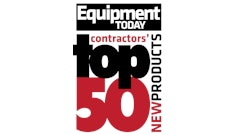Tier II emission requirements have been a challenge for all manufacturers of off-highway equipment. However, they posed a special challenge for compaction equipment manufacturers, who faced tight space constraints, an extremely price-sensitive market and increased noise concerns.
Over the last two years, compaction equipment designers had to wrestle with some fundamental choices when it came to bringing their products into compliance. And they didn't have much time to do it. "Unless you make your own engines, you are at the mercy of the engine manufacturers," says Steve Wilson, manager, marketing services and product manager for Compaction America.
One early problem was the availability of prototype engines. "That was critical because you build everything around the engine and we couldn't get the parts fast enough," says Dale Starry, manager of training and applications at Ingersoll-Rand's Road Development Group.
There was also some loss of available horsepower options — especially in the 100-hp range — as engine manufacturers opted to stop production on some lines in order to meet Tier II standards for their other products. That meant many equipment manufacturers had to utilize Tier II phase-in allowances, which permitted them to produce some non-compliant equipment as long as the majority of their machines met the emission standards.
Design challenges
The basic choices confronting manufacturers of compaction equipment were selecting a smaller but "cleaner" engine; adding an aftercooler to lower the temperature of the turbocharged air entering the engine; or adding electronic controls.
Some elected to use slightly smaller engines, but that carries marketing consequences. "In North America, contractors like performance, and it is considered a negative to take performance down," says Wilson.
Adding an aftercooler presented space challenges. "There's not a lot of room in the engine bay area and you're already dealing with additional heat rejection from the Tier II engines," Wilson explains.
Most manufacturers increased the size of the radiators to address the heat rejection issue. This made it much more difficult to add another cooling unit in the limited engine compartment. "It is like stuffing six pounds of sugar into a five-pound bag," says Starry.
The added cooling requirements also presented noise challenges. Europe already has specific noise emission regulations, and OSHA has been cracking down, as well. "Noise is and will be a bigger jobsite issue in the future," says Terry Sharp, manager, solutions and services, Caterpillar Global Paving. Caterpillar is already providing low-noise, variable fan speed, ATAAC cooling systems in advance of any specific regulations.
Other manufacturers have been concerned with increasing the size of the cooling fan. Some switched to quieter, hydraulically driven fans; others changed muffler systems.
Electronics vs. aftercoolers
Choosing whether to go with electronics or charge-air cooling was not an easy task. "You have to juggle complexity, cost and tight packaging," says Starry. "The choice is between electronics, which are more costly but take up less space, and charge-air cooling, which is less expensive but creates packaging problems."
The price differential for electronics is significant, adding as much as 25 percent to the cost of the engine. Compaction equipment manufacturers with their own engine lines have been able to minimize this price impact.
"Since Caterpillar makes its own engines, we have the advantage of a long-term commitment to emissions compliance, while spreading the cost over a wide range of products," says Sharp. "This also helps provide both electronic engines and advanced cooling systems as an integrated package for compaction products."
Manufacturers relying on outside engine suppliers, however, have been forced to absorb the added cost electronics bring. Electronics can also impact other equipment issues since they require the use of gold connectors and new electrical harnesses.
On the plus side, electronics add more to the engine than better emission control. "You have a much more stable-running engine," Wilson says. "Your fuel economy goes up and your torque range stays up, which gives you stability of operation."
Other benefits include easier engine diagnostics and more opportunity for integrated machine controls.
Many manufacturers utilize both electronics and aftercoolers, depending on the size class of the machine. On its 100- to 150-hp compactors, Ingersoll-Rand added charge-air cooling and a fuel cooler, while it turned to electronics for models rated above 150 hp.
Dynapac, on the other hand, elected to stick with the aftercooler strategy. "The new requirements affected our 100-hp models and up, which consist of approximately 18 models," says Nono Bauleth, Dynapac's service manager for North American operations. He explains that the company did a "small redesign" to modify the shape of its radiator and air cooler in order to make room for the aftercooler.
Absorbing the cost
The one option equipment manufacturers didn't have was to recover the costs of the new engines and redesign through price increases. One reason is the compaction market is dominated largely by rental firms. Concerned they would have a hard time passing on potential cost increases to end users, many rental companies chose to purchase older, less-expensive models before the regulations took affect. This meant there was less demand for the Tier II-compliant machines.
"You can't avoid the future," says Sharp. "Over time, all segments have to have compliant product."
"It is a highly competitive market," says Wilson. "You can't take the price up significantly because we are coming out of an economic downturn. We had to be very intelligent and more imaginative with what we did. We had to look at ways to improve manufacturing processes and bring down costs."
"We have had to absorb the cost of the newer, more expensive engines as well as modifications for the aftercooler," Starry agrees. "We feel the market is such we can't pass the price increase along to the end user."
















